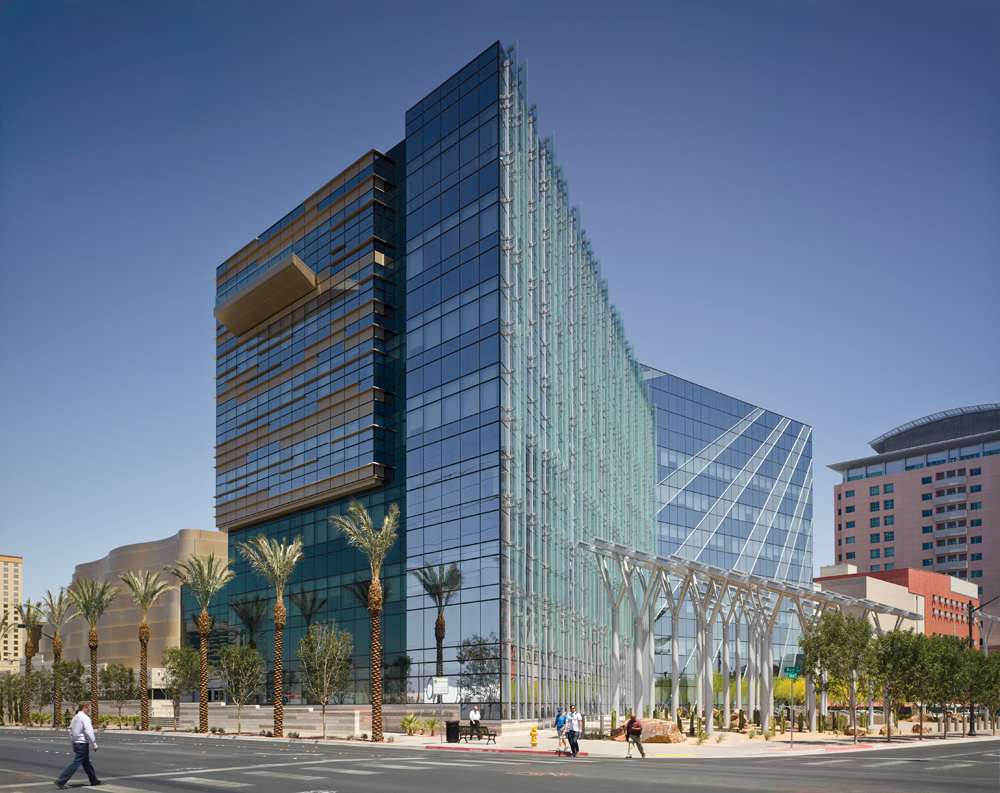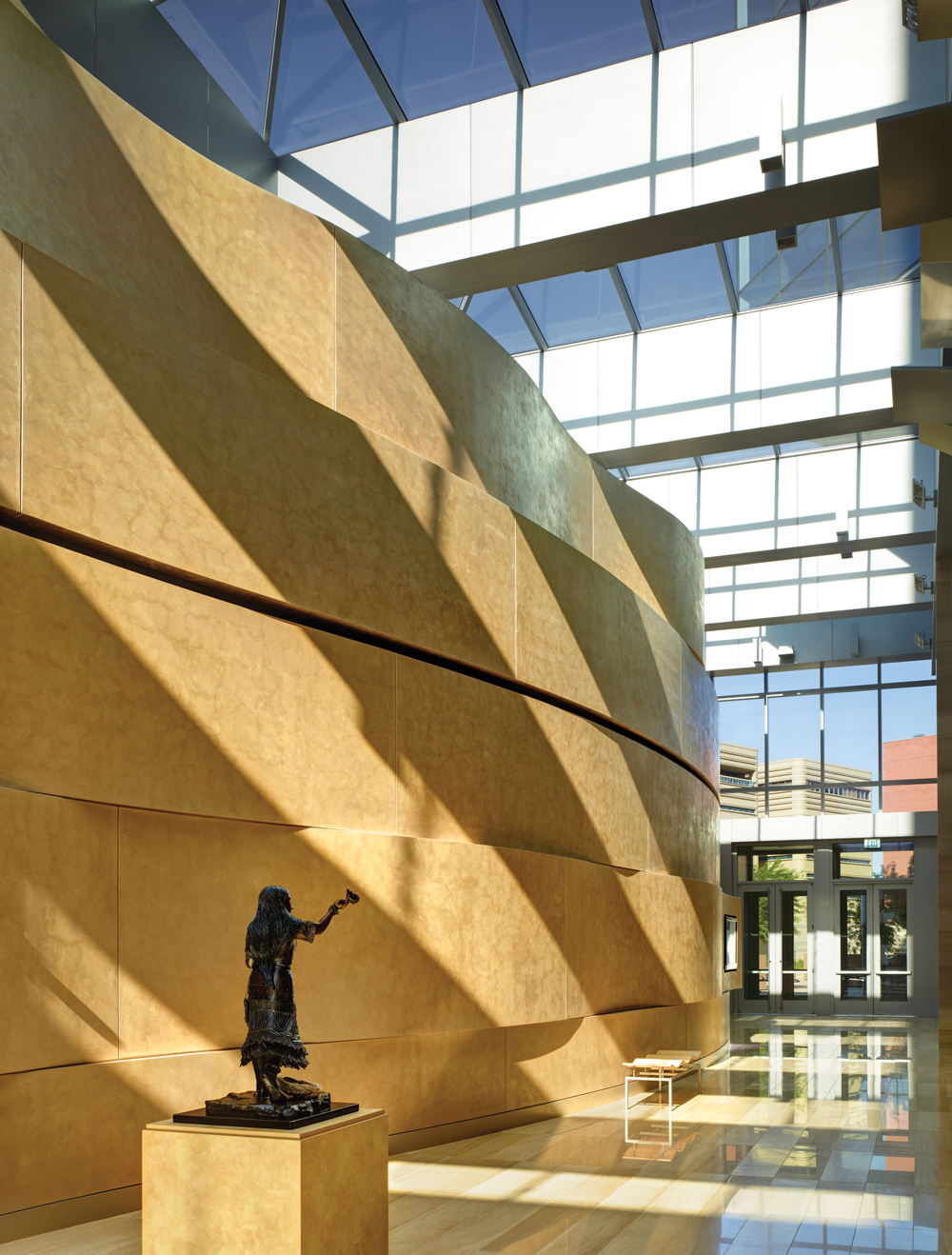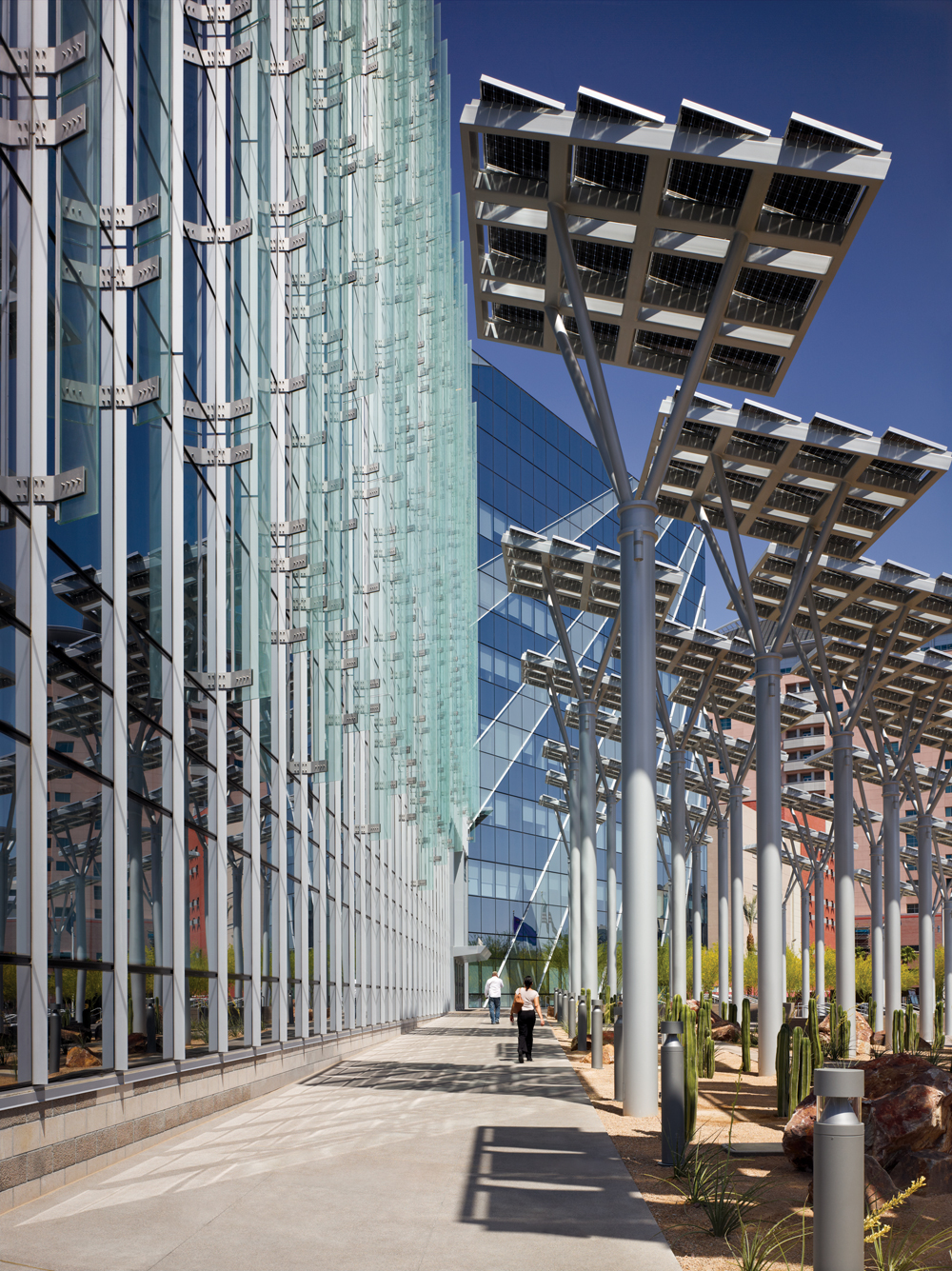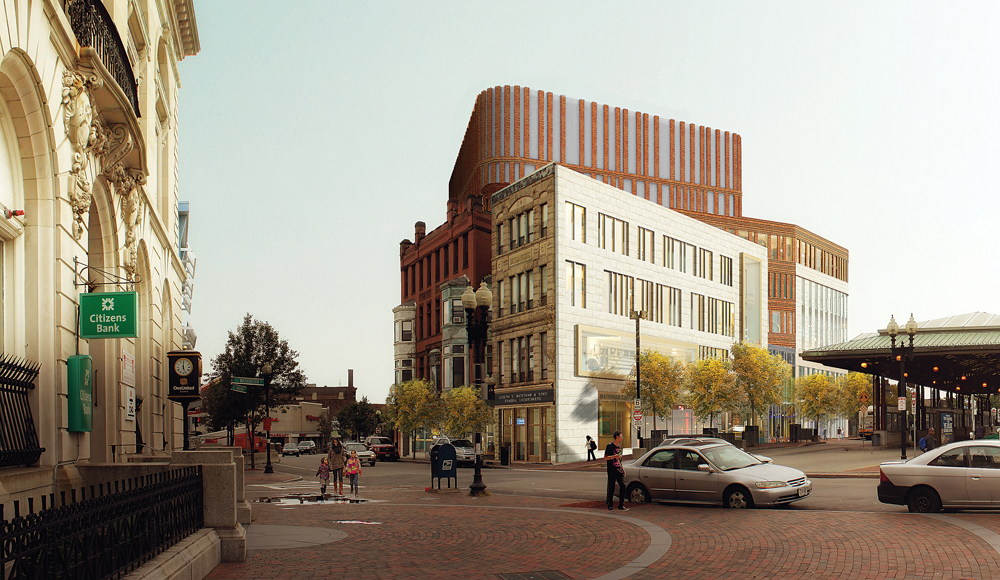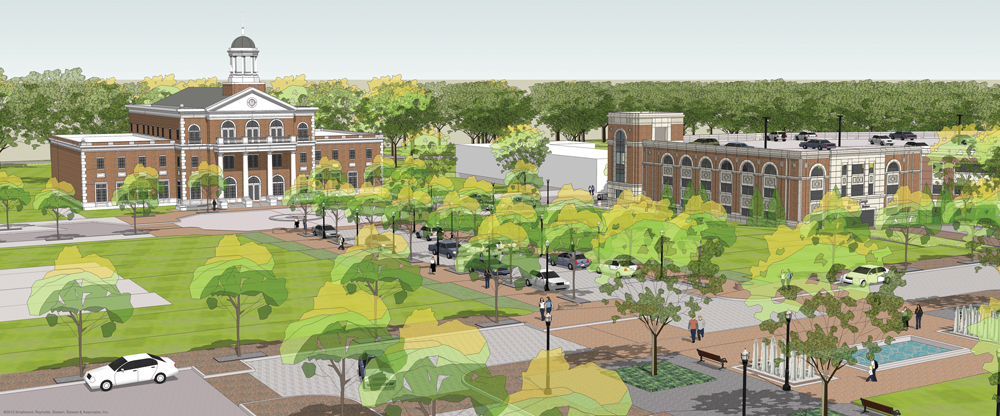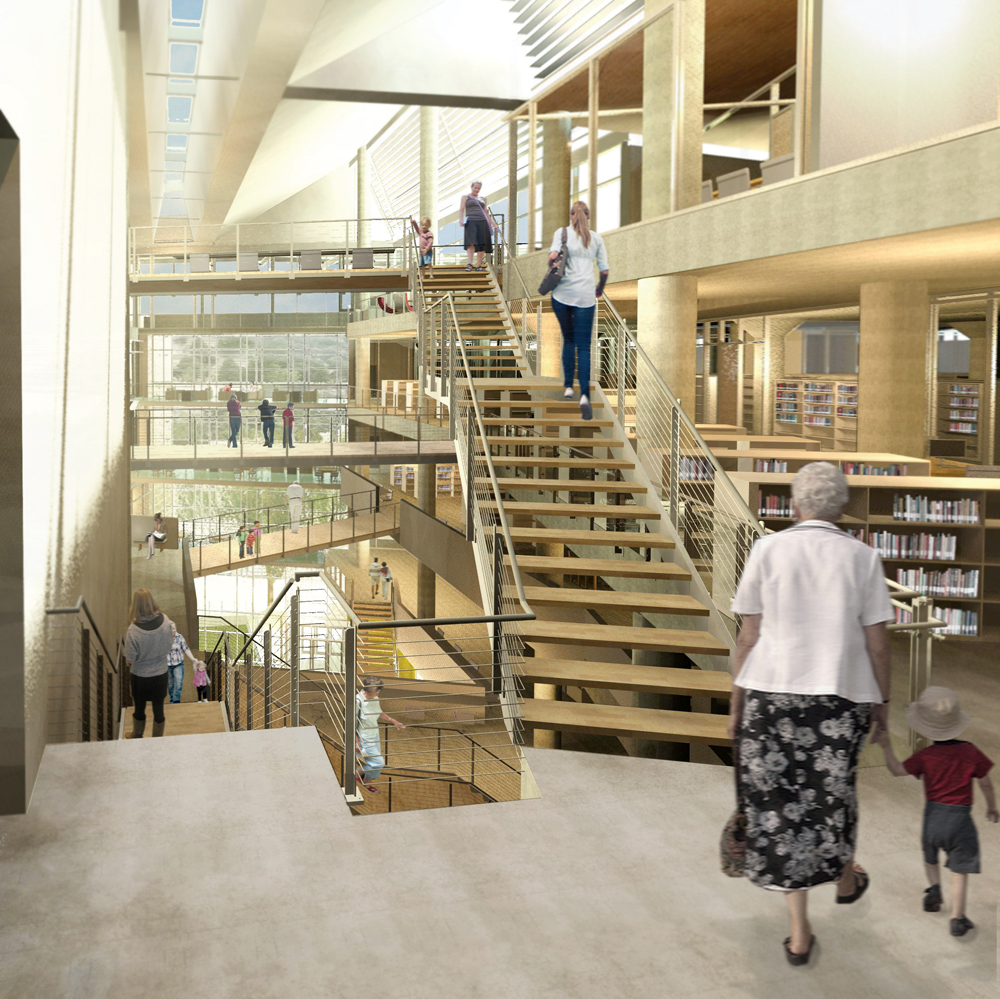The mid-20th century (and perhaps a few decades beyond) saw the construction of many local Brutalist-style city halls, libraries, police and fire stations, and administrative office buildings that more closely resembled bunker-like monuments to power than they did places of civility, comfort, and respite for the public they were meant to serve.
Recent municipal and county projects are being designed to be much more open and inviting to the local citizenry in an attempt to recalibrate the public’s relationship with local officials and institutions. Some go a step further, striving also to be catalysts for neighborhood revitalization that will draw more people and new businesses to neglected areas.
Building Design+Construction examined several new city and county projects that exemplify these trends. What we found could signal a movement toward local government projects that not only relate more closely to the community, but also help fuel neighborhood economic development.
1. AS ALWAYS, START WITH THE RIGHT LOCATION
Cities usually have more than one choice about where to site a prominent new municipal building. Besides looking at property values and site development costs, public officials and their Building Team partners must first ask: Will the site be convenient for city workers and the public to access? Can a less desirable city-owned property be sold to help pay for a new building at the right location? Would it be more cost-effective to renovate and adapt an existing building, rather than building new?
How to win local government projects
1. As always, start with the right location.2. Think big, think holistically.3. Provide plenty of public gathering areas.4. Be creative with amenities.5. Make your design open and welcoming.6. Use local history to make a design statement.
Some new local government projects probe further: Which location would generate the heftiest economic boost? For instance, the downtown site of the new seven-story, 308,000-sf Las Vegas City Hall lies in an economic dead zone. The new project is the centerpiece of a grand downtown revitalization plan advocated by Oscar Goodman, the flamboyant former mayor (1999-2011). “It is part of the former mayor’s vision for a total transformation of downtown,” says Howard Elkus, Elkus Manfredi Architects (www.elkus-manfredi.com), the design firm for the building.
Using his considerable lawyerly skills, Goodman pushed the controversial project through the city council in the midst of the 2008-2009 recession, and even secured low-interest federal Build America bonds to finance it.
Located about 10 miles from the Las Vegas Strip, the 2.75-acre site is bounded on the west by a 61-acre parcel dominated by a rail yard and surrounded on the other three sides by mostly decrepit structures. The master plan calls for the redevelopment of a five-block area. “If you imagine the neighborhood as a mall, consider City Hall the anchor tenant,” says Michael Vlaovich, AIA, Project Manager, City of Las Vegas Public Works.
The Las Vegas City Hall’s two distinctive shapes—the curvilinear, 430-seat city council chamber and the angular seven-story glass office tower housing the city’s administrative departments—come together in the lobby’s prefunction space. Providing places of congregation like this is an important selling point for the new generation of municipal and county buildings. © BRAD FEINKNOPF
Completed in 2012, the new $109.3 million, LEED Gold City Hall houses more than 500 employees. They now patronize nearby restaurants, retail shops, and service providers, injecting new economic vitality into the neighborhood. Add a new concert hall and children’s museum nearby at the old rail yard site, and a variety of other commercial and cultural projects that are about to open, and you’ve got a rebuilt, thriving neighborhood. The city estimates 13,000 new jobs and up to $20 million in new tax revenue will result from this downtown renaissance, although such projections always have to be viewed somewhat skeptically. Meanwhile, the old City Hall, in another part of downtown, has been sold to Zappos.com; it will host 2,000 employees of the online shoe retailer.
Stimulating neighborhood rebirth takes leaders who think big and are extremely persistent. Boston’s new school headquarters in the Roxbury neighborhood presents such a case. The location, known as Dudley Square, contains a historic building that had been vacant for over 40 years. Various proposals to redevelop the area had been advanced by federal and state officials in recent decades, only to be abandoned. As we’ll see, it took a determined effort by Mayor Thomas M. Menino to finally get the project moving.
The takeaway: Advise your public-sector clients to consider how a new municipal or county project could inject new life into an economically moribund area. Pose this question: “Where could we create the biggest economic shot in the arm, at the most reasonable cost?”
In some cases, this line of thinking may lead to a specific site that could be more costly to develop than other alternatives, but have a greater long-term payoff in terms of neighborhood revitalization. That’s when your team will need to work with civic leaders to make a compelling case to taxpayers regarding the far-reaching benefits of going with the more expensive option.
2. THINK BIG, THINK HOLISTICALLY
Sometimes it’s better to set aside timidity and think big, by proposing multiple complementary projects that will garner support from a wider swath of the community.
That’s what happened in Boston, where 20-year-incumbent Menino (who recently announced he will not run for reelection) kept urging his planning staff to think big about the new school headquarters. “It wasn’t like we were going to plunk down the building and walk away,” says Patrick Brophy, Assistant Director of Operations of Capital Construction Division in the city’s Property and Construction Management Department. The idea was to schedule public- and private-sector projects so that the area would receive a major economic jolt to spur private-sector investment. “We didn’t want a 20-year slow leak of investment,” says Brophy. This strategy required years of planning and detailed coordination with multiple stakeholders, including electric, telecommunications, and natural gas providers.
For Sasaki Associates (www.sasaki.com) and its partners on the school headquarters project—Dutch firm Mecanoo architecten (www.mecanoo.nl), Arup (www.arup.com), and CM at risk Shawmut Design & Construction (www.shawmut.com)—neighborhood revitalization figured prominently in the thinking behind the six-story, $115 million building, which will house more than 500 full-time employees. The 200,000-sf facility’s large, open lobby and main entrance are oriented to create a direct line of sight to the bus station across the street. In addition, the neighborhood is undergoing a complete infrastructure rebuild—roads, utilities, even traffic signals. The local police station was replaced with a new structure, and the branch library is being renovated. All this activity has been taking place over an 18-month period.
The solar “tree farm” in the plaza at Las Vegas City Hall—33 tubular columns, 25 to 35 feet in height, mounted with photovoltaic panels that generate 7% of the building’s annual energy use. The LEED Gold building’s sustainable design also avoids 240,000 metric tons of greenhouse gas emissions. © BRAD FEINKNOPF
This infusion of public dollars and spirit seems to be having the hoped-for effect. Nuestra Comunidad Development Corp. is expected to begin construction soon on Bartlett Place, a mix of 323 housing units, offices, and retail shops on the site of a former bus yard just outside Dudley Square. On land cleared by the Boston Redevelopment Agency, design/development firm Urbanica plans to construct a hotel/housing complex, while Tropical Foods and the Madison Park Development Corp. are building new offices, apartments, and a grocery store. And the city’s Director of Neighborhood Development, Sheila Dillon, has told the Boston Globe she’s getting numerous calls from developers inquiring about publicly owned land in Dudley Square.
The "Big Vision" Approach is also being put to work by the city of Alpharetta, Ga., which is using its new 48,000-sf city hall as a means to create a central locus for the community. “We’ve been a fairly small city until recently,” says City Administrator Bob Regus. “We’ve never had much of a downtown.” The city, an emerging high-tech center about 25 miles north of Atlanta, grew by 65% in the 2000s, to 58,000, with a median family income of more than $95,000.
As plans for the new city hall evolved, Alpharetta kept thinking bigger, buying up vacant and underused properties until it put together a 20-acre site that eventually will include a new 25,000-sf county library, a 450-space parking structure, and five acres of parkland that will create the city’s first downtown gathering space. A “town green” is envisioned to hold concerts, fairs, and other civic gatherings. Various agencies are involved in developing design guidelines to give the new city hall and surrounding structures a cohesive look and feel.
The takeaway: A new civic building can be the centerpiece of a coordinated effort to remake a neighborhood, especially if it can be the catalyst for complementary development that adds critical mass for economic growth.
[pagebreak]
3. PROVIDE PLENTY OF PUBLIC GATHERING AREAS
For the new generation of civic buildings, providing multiple spaces for neighborhood events is becoming a crucial component of design—and a proven way to generate widespread support from taxpayers.
That’s one reason the new $31 million, 48,000-sf Alpharetta City Hall will have a multipurpose room on the main floor for use by community groups. “We allow groups to use the council chamber in the existing city hall, but these events can be rough on the furniture and floors,” says City Administrator Regus. Having the new facility should solve that problem.
Outdoor amenities are also becoming a more common component of civic projects. For example, the community room in Alpharetta’s city hall will connect with an outdoor plaza to provide additional space for public gatherings. The Boston Public Schools headquarters will feature a second-floor meeting space with flexible partitions to accommodate community meetings of various sizes on weekends and on weekday evenings when official business is not being conducted. (There’s even talk of allowing neighborhood residents to rent the space for birthday parties and other private celebrations.) The building’s landscaped rooftop patio, offering spectacular views of downtown Boston, will also be available for public events.
Two views of the Dudley Square Municipal Office Facility, keystone of the redevelopment of Boston’s Roxbury neighborhood. The Building Team for the $115 million Boston Public Schools headquarters is being led by Sasaki Associates (architect/CE/landscape/interiors), with Mecanoo International (architectural design collaborator), Arup (MEP/SE/FP), McPhail Associates (geotechnical engineer), Weston & Sampson (environmental engineer), Building Conservation Associates (historic preservation consultant), Lam Partners (lighting), Cavanaugh Tocci Associates (acoustical), ACT Associates (AV), and Shawmut Design and Construction (CM at risk). Renderings: Mecanoo International
In Austin, Texas, a new 198,000-sf central library will be topped with a landscaped terrace offering dramatic vistas of the downtown environs, notably that of nearby Lady Bird Lake. Las Vegas’s new City Hall offers a similar events venue on a second-floor outdoor plaza, which also serves as an informal lunch spot for area workers. The building’s interior features a 430-seat, acoustically tuned Council Chamber, equipped with theatrical lighting, A/V systems, movable walls and cyclorama curtain to host community artistic performances and special events. Access to all these spaces is controlled or monitored by security personnel.
The takeaway: Work with public officials responsible for programming these buildings to explore how these structures can play multiple roles for the community at large. When a city or county adds a prominent new structure to the landscape, the building should provide multiple uses and benefits for everyone—not just government employees—to enjoy.
4. BE CREATIVE WITH AMENITIES
Public buildings at the local level have to be neighborhood friendly. To that end, the Austin Central Library planners have set aside leasable space for restaurants and retail stores, notably a popular used bookstore run by the library itself. Boston is reserving space for mixed-use retail—“the first time the city has ever tried to put retail space into a city building,” says Brophy.
Amenities like these should not be an afterthought; they can be crucial components of a grander scheme. The planned restaurant in Boston fills a void. “The area is commercially and socially dead after dark,” says Victor Vizgaitis, AIA, LEED AP, Principal, Sasaki Associates. “There are few restaurants open after lunchtime.” That’s one reason Sasaki’s designers expanded retail/restaurant space from 8,000 sf to 18,000 sf, a change that garnered strong support from neighbors hungering for such quality-of-life amenities.
In Austin, the library’s eatery will serve a rapidly developing neighborhood. The city is constructing a bridge over the adjacent Shoal Creek to extend Second Avenue, Austin’s thriving downtown commercial strip, past the library. Private developers are putting up new apartment and mixed-use complexes nearby. The library’s restaurant, which will connect with a patio for al fresco dining, is expected to draw more patrons and add an important social dimension to this fast-emerging neighborhood.
Overview of the greater Roxbury area of Boston, site of a major redevelopment envisioned by Mayor Thomas N. Menino. Dudley Square is on the left, with the renovated branch library at center left and the new Roxbury neighborhood police station at right. The area is also undergoing a complete refitting of public infrastructure—roads, utilities, even traffic lights—as a spur to private investment. Photo: Sasaki Associates
Two other spaces in Austin’s library speak to the area’s outdoor-oriented lifestyle. Two screened, shaded, open-air porches furnished with rocking chairs—one in the children’s section with seating for 60, another in the adult area that will seat 45—
will look out over Shoal Creek and the nearby lake. The city’s warm climate means library visitors can read and relax in these spaces most of the year.
The open-air porches stirred up controversy at first, according to Sidney R. Bowen, AIA, Managing Principal, Shepley Bulfinch (www.shepleybulfinch.com), the joint-venture architect with Lake|Flato Architects (www.lakeflato.com). Librarians feared that some patrons might try to steal items from the collection by throwing them from the porch, but those fears were allayed when the designers added screens to prevent such nefarious activities by the book-reading public.
A bicycle garage under the library is another Austin-style amenity. “There will be more parking spaces for bikes [150-200] than for cars,” says Bowen. Plans call for the bicycle parking station to be leased to a bike repair shop, which will collect parking fees and offer maintenance services for cyclists while they visit the library.
The takeaway: These projects show that local government decision-makers are increasingly open to proposals with innovative amenities that line up with a project’s overall goals. One way to discern what will be appealing is to analyze neighborhood amenities and consider how space in a new building could enhance the quality of life.
5. MAKE YOUR DESIGN OPEN AND WELCOMING
Civic projects cry out for prominent elements in and around their entrances to encourage visitors to come inside. After all, these are public buildings.
Boston’s old police station in Dudley Square was built in the late 1960s with no windows. “The neighborhood wanted a design where you didn’t feel like you were intruding on the bunker,” says Brophy. The new police station features floor-to-roof fenestration around the entrance, with a brightly lit lobby—a signal to the neighbors to engage with their local police in community-based crime prevention.
The Municipal Office Facility embraces transparency as well, with large, bold fenestration lining the lower floors of the modern areas of the façade, allowing passersby to peer into the daylight-flooded, open lobby. And the entrance to the Dudley Square library, another Brutalist monument, was remodeled with better lighting and a huge, colorful sign to make the facility more easily identifiable.
The takeaway: During programming, work with area residents to evaluate their desire for more welcoming public facilities.
6. USE LOCAL HISTORY TO MAKE A DESIGN STATEMENT
Historic elements can and should enrich civic projects, making them more of a draw to visitors and thereby enhancing their value proposition. This was certainly the case for the $109.3 million Las Vegas City Hall, which became a kind of diorama of the city’s geological past.
After an early conceptual design was rejected, Howard Elkus delved into the region’s geological history for inspiration. He learned that the name “las vegas” means “the meadows,” a reference to the time when verdant grasses fed by an underground spring made the valley a lush home to the Southern Paiute. The curvilinear form of the 430-seat council chamber was inspired by the mounds created by the spring, represented in the undulating sand-colored walls and metallic-ribboned ceilings.
Nearby Hoover Dam, which helped shape Las Vegas into a modern, neon-drenched city, is reflected in the vertical glass fins of the façade, signifying the flow of water through the intake towers of the dam’s turbines. Horizontal bands in the main structure portray the earthen layers in the Black Canyon where the dam is located. The Grand Lobby’s horizontally veined stone floor and walls recall the stratified rock layers visible on the canyon walls. The illuminated glass sculpture of the Grand Staircase calls to mind the energy of the Colorado River, while gigantic concrete blocks emulate the dam’s muscular form.
A view of the future downtown of Alpharetta, Ga., a rapidly growing suburb about 25 miles north of Atlanta. Jones Lang LaSalle is the program manager for the city, with the Building Team of Smallwood, Reynolds, Stewart, Stewart (architect), David M. Schwarz Architects (associate architect), Uzun & Case (SE), HESM&A Inc. (MEP/FP), URS Corp. (CE to the owner), Metromont Corp. (precast parking deck), and Choate Construction Co. (GC). Rendering: Smallwood, Reynolds, Stewart, Stewart
Solar power, a key technology of the future for this city of abundant sunshine, is represented by decorative rays that adorn the east-wing façade. These rays lead to 33 photovoltaic “trees,” 25- to 35-foot steel structures that shade the main plaza during the day and are expected to produce 290,000 kWh of electricity a year, or 7% of the building’s energy needs. The photovoltaics illuminate glass fins on the façade in a changing display of colored LED lights—a new landmark in the city’s nightscape.
Similarly, Boston’s Municipal Office Facility will preserve the historic façade of the neighborhood’s most prominent landmark, the flatiron-shaped Ferdinand’s Furniture Building. Many Bostonians of a certain age have fond memories of trips to this store as children, notes Vizgaitis. “If you bought your furniture there, it was a sign of success,” he says.
The design also incorporates the historic Curtis and Waterman buildings to create a triangle of historic façades connected by new construction. The restored Ferdinand, Curtis, and Waterman shells will maintain the historic scale of Dudley Square, even as the new building seeks to blend a modern aesthetic in between. Preserving these façade gems, replete with ornate terra cotta and detailed brickwork, added $4 million in costs to the project. The construction manager, Shawmut, will also have to deal with a three-foot front-to-back differential between the old buildings.
The building’s interior lobby space also adds historic references—orange panels and stripes that recall the former elevated Orange Line trolley, which used to dominate Dudley Square from across the street. “We’ve made an effort to recall where that was with storytelling signage and graphics,” says Vizgaitis.
The takeaway: Communities looking to build iconic, 100-year buildings may be willing to spend what it takes to achieve imaginative design if they can embrace a grand vision that will spark economic revitalization. These projects require innovative conceptualization, and often take several years to build public support, generate funding, and secure approvals. With a strong commitment to seeing things through, however, Building Teams and their civic partners can construct award-winning community assets that last generations.
Austin embraces the flexible, evolving library
As libraries morph from book repositories to digital-age institutions, designs must emphasize flexibility in the use of space. Increasingly, clients also want Building Teams to provide commons areas where patrons, visitors, and staff can interact.
The old central library in Austin, Texas, which opened in 1979, has no gathering or meeting spaces to speak of. It was conceived in an era when the primary function of a library was to store books and protect them from sunlight, says Sidney R. Bowen, AIA, Principal with Shepley Bulfinch (www.shepleybulfinch.com), the architect for the new library with Lake|Flato Architects (www.lakeflato.com).
The new $90 million, 198,000-sf library will still have books, but a lot fewer of them, due to the availability of digital technology. “We can try to guess what the library of the future will be, but we’d probably be wrong,” says Bowen. Thus, the design minimizes permanent interior walls, and all bookshelves will be set on casters. “We want the building to last 100 years, not just structurally, but functionally,” he says.
John Gillum, Facilities Process Manager for Austin’s library department, says he and his staff originally thought the building would have to be much bigger—350,000 sf—but that thinking changed during the design process. “We decided that if we relied more on technology, we could have a smaller footprint,” he says.
Some of the space that once might have held books will be replaced with space for congregating. There will be a tiered seating area suitable for such nontraditional library events as cooking classes. A 2,500-sf multiuse room, set up like a large hotel meeting space outfitted with high-tech A/V equipment, will seat up to 500. A ground-floor café and a rooftop terrace provide more opportunities for people to gather.
Increasingly, libraries will be conceived more as public squares than quiet places to read and study—though, in the case of the Austin library, several rooms will be reserved for those purposes. “We all spend too much time on computers by ourselves,” says Gillum. “We want places where we can rub shoulders with other human beings.”
Rare books will be stored at the city’s other libraries, allowing the new library to be flooded with sunlight. “Daylight is the best type of reading light,” says Bowen. “We think this library will be second to none in the U.S. in terms of daylighting.” In Austin’s hot climate, though, maximizing daylighting while controlling energy use is a complex task. “To get light without heat requires a lot of scrim and a huge amount of modeling,” says Bowen.
Building Team: Lake|Flato Architects/Shepley Bulfinch (JV architects), Datum Engineers and P.E. Structural Consultants (SE), Jose I. Guerra Inc. (M/E engineer/energy modeling), Hartunian Engineering (electrical service engineer), Encotech Engineering (plumbing engineer), Urban Design Group (CE), Rolf Jensen & Associates (FP), Coleman & Associates (landscape architect), Simpson Gumpertz & Heger (building envelope), HOLOS Collaborative (LEED consultant), and Integration Design Lab/University of Washington (daylighting consultant).
Related Stories
Codes and Standards | Jul 17, 2023
Outdated federal rainfall analysis impacting infrastructure projects, flood insurance
Severe rainstorms, sometimes described as “atmospheric rivers” or “torrential thunderstorms,” are making the concept of a “1-in-100-year flood event” obsolete, according to a report from First Street Foundation, an organization focused on weather risk research.
Multifamily Housing | Jul 13, 2023
Walkable neighborhoods encourage stronger sense of community
Adults who live in walkable neighborhoods are more likely to interact with their neighbors and have a stronger sense of community than people who live in car-dependent communities, according to a report by the Herbert Wertheim School of Public Health and Human Longevity Science at University of California San Diego.
Contractors | Jul 13, 2023
Construction input prices remain unchanged in June, inflation slowing
Construction input prices remained unchanged in June compared to the previous month, according to an Associated Builders and Contractors analysis of U.S. Bureau of Labor Statistics Producer Price Index data released today. Nonresidential construction input prices were also unchanged for the month.
Government Buildings | Jul 13, 2023
The recently opened U.S. Embassy in Ankara reflects U.S. values while honoring Turkish architecture
The U.S. Department of State’s Bureau of Overseas Buildings Operations (OBO) has recently opened the U.S. Embassy in Ankara, Turkey. The design by Ennead Architects aims to balance transparency and openness with security, according to a press statement. The design also seeks both to honor Turkey’s architectural traditions and to meet OBO’s goals of sustainability, resiliency, and stewardship.
Affordable Housing | Jul 12, 2023
Navigating homelessness with modular building solutions
San Francisco-based architect Chuck Bloszies, FAIA, SE, LEED AP, discusses his firm's designs for Navigation Centers, temporary housing for the homeless in northern California.
Sponsored | Fire and Life Safety | Jul 12, 2023
Fire safety considerations for cantilevered buildings [AIA course]
Bold cantilevered designs are prevalent today, as developers and architects strive to maximize space, views, and natural light in buildings. Cantilevered structures, however, present a host of challenges for building teams, according to José R. Rivera, PE, Associate Principal and Director of Plumbing and Fire Protection with Lilker.
Building Owners | Jul 12, 2023
Building movement: When is it a problem?
As buildings age, their structural conditions can deteriorate, causing damage and safety concerns. In order to mitigate this, it’s important to engage in the regular inspection and condition assessment of buildings for diagnosis.
Mass Timber | Jul 11, 2023
5 solutions to acoustic issues in mass timber buildings
For all its advantages, mass timber also has a less-heralded quality: its acoustic challenges. Exposed wood ceilings and floors have led to issues with excessive noise. Mass timber experts offer practical solutions to the top five acoustic issues in mass timber buildings.
Multifamily Housing | Jul 11, 2023
Converting downtown office into multifamily residential: Let’s stop and think about this
Is the office-to-residential conversion really what’s best for our downtowns from a cultural, urban, economic perspective? Or is this silver bullet really a poison pill?
Adaptive Reuse | Jul 10, 2023
California updates building code for adaptive reuse of office, retail structures for housing
The California Building Standards Commission recently voted to make it easier to convert commercial properties to residential use. The commission adopted provisions of the International Existing Building Code (IEBC) that allow developers more flexibility for adaptive reuse of retail and office structures.


